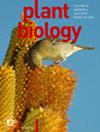诱饵,而不是奖励:富含二氧化碳的猪笼草会分泌有毒的花蜜。
IF 3.6
3区 生物学
Q1 PLANT SCIENCES
引用次数: 0
摘要
猪笼草是由叶子进化而来的生物陷阱,里面含有高浓度的二氧化碳。花蜜(EFN)的分泌一直被认为是对来访的节肢动物的主要奖励,但其化学成分及其在猎物捕获中的作用却很少被探索。本研究分离了戊草属植物的efn,并采用hptlc -密度测定法、UFLC和生化分析方法对其糖、氨基酸、蛋白质、维生素C和脂肪酸进行了分析。用CHNS法、ICP-OES法和顶空- gc - ms法分别测定efn的C:N比、矿物质和挥发物;采用LC-MS进行代谢谱分析。采用乙酰胆碱酯酶(AChE)抑制法测定胃壁/盖EFNs及其有效成分;通过生物活性引导分离和光谱学对AChE抑制剂进行了表征。在这里,我们证明了猪笼草EFN是一种糖(葡萄糖-果糖-蔗糖)混合物,具有高C:N比,最少的氨基酸,蛋白质和维生素C。萘醌衍生物(+)-异草胺酮被鉴定为AChE抑制剂。莲蓬草中挥发性萘醌的主要成分白桦苷对乙酰胆碱酯酶也有较强的抑制作用。直接饲喂EFN-和(+)-异草胺酮生物测定显示蚂蚁胆碱能毒性症状。鼠戊草EFN是一种毒性饵料,可抑制来访节肢动物的神经活动。它们的猪笼草在捕捉猎物时采用了各种欺骗策略,我们的研究推翻了猪笼草EFN是对来访的蚂蚁和其他节肢动物的奖励的观点。此外,我们的研究结果表明,在猪笼草的生长、代谢、食草性和食肉性中,猪笼草体内二氧化碳水平的升高起着至关重要的作用。本文章由计算机程序翻译,如有差异,请以英文原文为准。

Bait, not reward: CO2-enriched Nepenthes pitchers secrete toxic nectar
求助全文
通过发布文献求助,成功后即可免费获取论文全文。
去求助
来源期刊

Plant Biology
生物-植物科学
CiteScore
8.20
自引率
2.60%
发文量
109
审稿时长
3 months
期刊介绍:
Plant Biology is an international journal of broad scope bringing together the different subdisciplines, such as physiology, molecular biology, cell biology, development, genetics, systematics, ecology, evolution, ecophysiology, plant-microbe interactions, and mycology.
Plant Biology publishes original problem-oriented full-length research papers, short research papers, and review articles. Discussion of hot topics and provocative opinion articles are published under the heading Acute Views. From a multidisciplinary perspective, Plant Biology will provide a platform for publication, information and debate, encompassing all areas which fall within the scope of plant science.
 求助内容:
求助内容: 应助结果提醒方式:
应助结果提醒方式:


